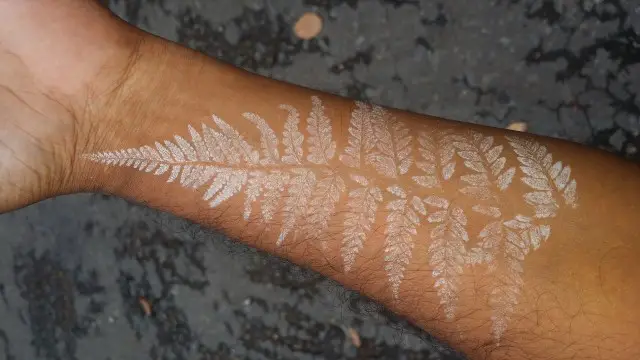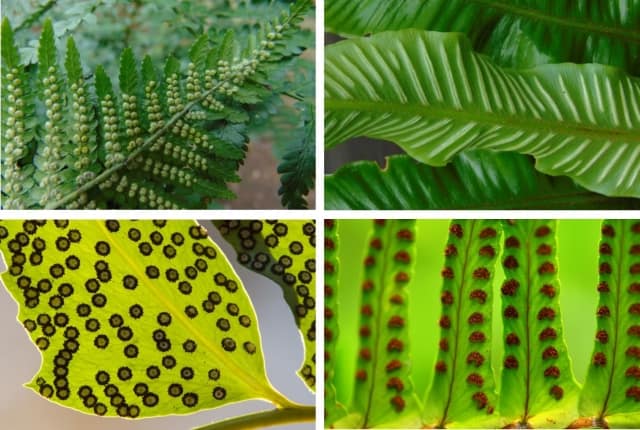Ferns are amazing plants. They have colonized every corner of the planet, have been around for hundreds of millions of years, and come in a tremendous variety of shapes, sizes, colors, and textures. They provide endless interest for the botanist or gardener, and are full of surprises – for example, not many people know that some ferns can give you a tattoo.
The silver and gold tattoo ferns are famed for their ability to transfer an intricate print of their fronds onto the skin. This temporary “tattoo” is actually the spores of the fern, which are transferred over when the underside of the frond is pressed against exposed skin. In effect, it creates a delicate and eye-catching natural painting that looks like a perfect copy of the fern’s elegant frond.

The silver tattoo fern (Pityrogramma calomelanos) and golden tattoo fern (Pityrogramma chrysophylla) – also known as silverback or goldback ferns – are not easy to source for domestic gardens, but are sometimes available from specialist nurseries. They are native to the Dominican Republic and so favor a warm, humid climate, but they can be grown successfully in large ranges of the United States. They are actually fairly robust plants, being tolerant of direct or partial sun, and a range of soil conditions (but ideally, moist and well-drained).
Their ability to create a tattoo comes from the dense dusting of spores that coat the back of the fronds, giving the ferns a beautiful coloration in their own right. This video shows the ferns in their natural environment in Dominica, and demonstrates the tattooing effect:
How are the tattoos made?
The pattern of the tattoo is formed from the spores of the silverback and goldenback ferns. Ferns evolved before flowering plants, and do not produce flowers, pollen or seeds. The spores are the fern’s equivalent to seeds – containing the genetic material needed for making a new fern.
Tattoo ferns are unusual in the color and quantity of spores that they produce. The underside of the frond is liberally coated in the tiny spores, so small as to be little more than specks of dust. When transferred onto the skin, the spores simply stick through contact, meaning the tattoo is very superficial, and can simply be brushed or washed off.
The spores are not troublesome or hazardous in any way. They will not irritate the skin or leave any lasting mark. It is a simple, harmless – but beautiful – momentary record of the delicate pattern of the fern’s shape.
What are spores?
All ferns produce spores, but most are useless for decorative purposes. The spores are generally located on the underside of the fronds, but the arrangement, color and density can vary significantly between species.
If you examine a fern in the garden, flip over the frond and have a look at the reverse. There will usually be distinctive patterning in the layout of the structures that contain the spores – in fact this is one of the ways that botanists use to classify fern species.

Most ferns have sporangia, which are small structures that contain the spores. These can be clustered together in sori, which can themselves be sometimes covered with a protective case called an indusia. All of this is set up to allow the spores to develop, and protect them until they are ready for dispersal.
Spores can spread on the wind, or when birds and animals brush against the fronds and carry spores away with them. Alternatively, in rare cases, curious humans might make a skin tattoo from them, which they then brush off some distance away from the parent plant.
The life cycle of ferns is more complex than flowering plants, as the spores cannot themselves germinate into new ferns. Spores form an intermediate state known as a gametophyte, which needs moisture to allow for fertilization to occur, before a new fernlet can develop. Their unusual life cycle is yet another way that ferns are fascinating.
Some species of ferns produce two separate types of fronds. One type does not produce spores, and so these sterile fronds will not have any patterning of sori on the reverse. The fertile fronds are usually quite different in shape and size, and these fronds are laden with spores. A striking example of this class is the cinnamon fern.

Cinnamon fern
- Osmunda cinnamomea
- Deciduous
- Prefers partial shade
- Height: up to 1.5 m
- Soil: acid. Moist, poor drainage tolerated.
Here the fertile fronds are obvious as upright structures that turn orange/brown in spring and summer, in dramatic contrast to the green sterile fronds that surround them.
Fern spores can be green, yellow, orange, red, brown, gray or black, depending on the species. In principle, therefore, it should be possible to use other ferns to make tattoos. In practice, though, the spores can be so small or plain to be invisible on the skin, or do not transfer easily or retain the pattern of the frond, forming a disordered dusting rather than a beautiful pattern.
That said, many horticulturalists who propagate ferns do start the process with striking a frond against a sheet of paper to collect the spores safely. This step of the process can result in a (maybe slightly dusty and drab) imprint of the fern as a short-lived hazy image before the spores are collected and sown.
Fern tattoos
As a last thought, true fern enthusiasts could take things a step further and get a fern tattoo, rather than a tattoo fern.

Patriotic New Zealanders sometimes opt for this stylish body art, as the silver tree fern of New Zealand, Cyathea dealbata, is their national symbol. These amazing plants are said to reflect moonlight on their white undersides, helping with navigation through the bush at night. The silver frond has been adopted as an emblem for the New Zealand sports teams, as well as numerous other cultural and social organisations.
Although they are difficult to come by, the silver and golden tattoo ferns are beautiful in their own right, and can also transfer that beauty as an ephemeral mark on the skin. If you can source them, and have a suitable spot in the garden where they can thrive, they can provide both horticultural elegance and a neat party trick to impress your friends.
